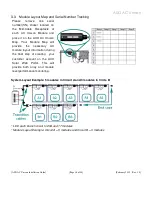
AUO AC Unison
[AUO AC Unison Installation Guide]
[Page 26 of 44]
[February 2012 Rev. 1.0]
-
WARNING: Shock Hazard. AC wiring is energized by both utility dedicated branch circuit(s) and AC Unison modules rated
as "Utility Interactive". Opening the array's dedicated branch disconnect will also cause the AC Unison modules to stop
producing power. Proper safety procedures must be followed when installing or accessing the dedicated branch circuit
wiring, which includes unplugging the AC Unison modules from the dedicated branch circuit.
-
The AC Unison module interconnecting cable system includes an internal equipment grounding conductor (EGC)
connected to each module through pluggable connectors with a longer ground pin.
-
The AC Unison module does NOT require a grounding electrode conductor (GEC), and the neutral within the AC Unison
module is isolated from ground.
-
The AC Unison module must be connected to a dedicated branch circuit from an AC supply system with the neutral
referenced at the building or structure service entrance.
-
The connector on the AC interconnecting cables is rated for disconnect under load and can be used as an NEC
disconnect device. Some authorities having jurisdiction (AHJ) may require a separate disconnect next to the AC Unison
module system as well as a readily accessible disconnect.
-
The AC cables and connectors are listed for outdoor use with AC Unison module applications and are rated for 20A, and
with insulation rated to a maximum temperature of 90°C.
-
The AC dedicated branch circuit wiring from the readily accessible disconnect to the AC Unison module array must
include an equipment grounding conductor (EGC) run in the same raceway or cable as the AC circuit conductors. This
EGC must be connected to the green colored conductor of the AC Unison module interconnecting cable system, transition
cable, using suitable wiring devices.
-
The AC Unison module interconnecting cable system provides an internal EGC for grounding the AC Unison modules only.
Other metal structures, such as mounting systems, must be grounded per code.
-
If a module is removed from within the string, it is recommended that you bridge the gap in the string using an AC
extension cable. Inserting an extension cable maintains ground continuity to subsequent modules in the string. Other
auxiliary grounding methods may be used.
-
The metal components of the AC Unison module, including frame and micro-inverter, can reach temperatures of
approximately 80°C or more under extreme environmental conditions. To reduce risk of burns, use appropriate safety
procedures when handling.
-
CAUTION: To reduce the risk of fire, connect only to a circuit provided with a dedicated 20 amperes maximum over
current protection in accordance with the National Electrical Code, ANSI/NFPA 70.
-
No more than 17 AC Unison modules can be connected to a single dedicated branch circuit.
-
The AC Unison module output is Utility Interactive.
-
To provide proper ventilation to the underside of the module, install modules with a minimum space of 1 inch between the
bottom of module and the mounting surface. The 1 inch is the minimum for the inverter CSA certification. However,
additional distance might be required to maintain a module back sheet temperature less than 85°C.
-
During shipping, the mid-cable receptacle is securely fastened to prevent movement. Use caution when unpacking the
module to ensure the mid-cable receptacle does not swing loose and cause damage to the module back sheet.
-
The installer must ensure that the AC cables and mid-cable receptacles are supported (will not sag to the roof or module
support structure) and are protected from excessive stress on the cord grip at the base of the mid-cable receptacle.
The AC Unison module is provided with an integral micro-inverter and is NRTL listed as an assembly for outdoor PV
applications. There is no direct current (DC) field wiring required and the integral micro-inverter has no serviceable parts inside.
The following caution is provided as part of the micro-inverter certification:
Summary of Contents for AC UNISON
Page 7: ...AUO AC Unison AUO AC Unison Installation Guide Page 6 of 44 February 2012 Rev 1 0 ...
Page 10: ...AUO AC Unison AUO AC Unison Installation Guide Page 9 of 44 February 2012 Rev 1 0 ...
Page 11: ...AUO AC Unison AUO AC Unison Installation Guide Page 10 of 44 February 2012 Rev 1 0 ...
Page 12: ...AUO AC Unison AUO AC Unison Installation Guide Page 11 of 44 February 2012 Rev 1 0 ...
Page 39: ...AUO AC Unison AUO AC Unison Installation Guide Page 38 of 44 February 2012 Rev 1 0 ...
















































